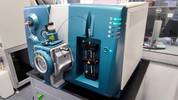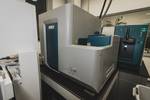CZ-OPENSCREEN uses different assays including biochemical (ligand binding and enzymatic activity assays) and cell-based assays (reporter, viability, apoptosis, cytotoxicity, proliferation, chemosensitivity, phenotypic and cell differentiation assays). Different readouts are available and routinely used such as luminescence, AlphaScreen, FRET/TR-FRET, HTRF, fluorescence intensity, fluorescence anisotropy, BRET, radioactivity-based scintillation and scintillation proximity assays, confocal microscopy, label-free impedance, and mass spectrometry. Most of the assays are miniaturized and are performed in 384- or 1536-well format.
Chemosensitive profiling
Chemosensitive profiling platform for systematic chemosensitive profiling of libraries of small molecules on the panel of cell lines of various histological origins. This service provides a unique complex information to chemist users about the potential clinical value of their compound library. The collection of cell lines represents cellular models for various types of cancers and is conceived to cover the most diverse types of tissues. Furthermore, each tissue is represented by one or more cell lines, according to the frequency that this type of oncological diseases contributes to the world's total cancer mortality. Systematic profiling of compound libraries provides information about the phenotypic changes, cytotoxic and anti-proliferative properties of compounds in each cell line. The association of obtained activity profiles with genetic background and specifically accumulated mutations in respective cell lines allows to identify specific pathways/processes/receptors utilised by small molecules.
Cell line
Organism
Site primary
Type
Classification
Primary Cell line
Description
Cell line
A-375
Organism
human
Site primary
skin
Type
cancer
Classification
melanoma
Primary Cell line
transformed
Description
amelanotic melanoma
Cell line
A-498
Organism
human
Site primary
kidney
Type
cancer
Classification
carcinoma
Primary Cell line
transformed
Description
renal carcinoma
Cell line
A-549
Organism
human
Site primary
lung
Type
cancer
Classification
carcinoma
Primary Cell line
transformed
Description
lung adenocarcinoma
Cell line
BJ
Organism
human
Site primary
skin
Type
normal
Classification
normal
Primary Cell line
primary
Description
fibroblasts
Cell line
BNL 1ME A.7R.1
Organism
mouse
Site primary
liver
Type
normal
Classification
normal
Primary Cell line
transformed
Description
normal hepatocytes
Cell line
BT-20
Organism
human
Site primary
breast
Type
cancer
Classification
carcinoma
Primary Cell line
transformed
Description
breast adenocarcinoma
Cell line
C17.2
Organism
mouse
Site primary
brain (cerebellum)
Type
normal
Classification
normal
Primary Cell line
immortalized
Description
neural progenitor or stem-like cells
Cell line
Caco-2
Organism
human
Site primary
colon
Type
cancer
Classification
carcinoma
Primary Cell line
transformed
Description
colorectal adenocarcinoma
Cell line
Caki-1
Organism
human
Site primary
kidney
Type
cancer
Classification
carcinoma
Primary Cell line
transformed
Description
clear cell carcinoma
Cell line
Caov-3
Organism
human
Site primary
ovary
Type
cancer
Classification
carcinoma
Primary Cell line
transformed
Description
ovarian adenocarcinoma
Cell line
D283 Med
Organism
human
Site primary
brain
Type
cancer
Classification
blastoma
Primary Cell line
transformed
Description
medulloblastoma
Cell line
DU 145
Organism
human
Site primary
prostate
Type
cancer
Classification
carcinoma
Primary Cell line
transformed
Description
prostate adenocarcinoma
Cell line
HCT116
Organism
human
Site primary
colon
Type
cancer
Classification
carcinoma
Primary Cell line
transformed
Description
colorectal adenocarcinoma
Cell line
HEK-293
Organism
human
Site primary
kidney
Type
normal
Classification
normal
Primary Cell line
normal, immortalized
Description
embryonic kidney cells
Cell line
HEK-293T
Organism
human
Site primary
kidney
Type
normal
Classification
normal
Primary Cell line
normal, immortalized
Description
embryonic kidney cells
Cell line
Hep G2
Organism
human
Site primary
liver
Type
cancer
Classification
carcinoma
Primary Cell line
transformed
Description
hepatocellular carcinoma
Cell line
HL-60
Organism
human
Site primary
blood
Type
cancer
Classification
leukemia
Primary Cell line
transformed
Description
acute myeloid leukaemia
Cell line
HT-29
Organism
human
Site primary
colon
Type
cancer
Classification
carcinoma
Primary Cell line
transformed
Description
colorectal adenocarcinoma
Cell line
HT29-MTX-E12
Organism
human
Site primary
colon
Type
cancer
Classification
carcinoma
Primary Cell line
transformed
Description
colorectal adenocarcinoma
Cell line
HuH7
Organism
human
Site primary
liver
Type
cancer
Classification
carcinoma
Primary Cell line
Description
liver carcinoma
Cell line
JAR
Organism
human
Site primary
placenta
Type
cancer
Classification
carcinoma
Primary Cell line
transformed
Description
Choriocarcinoma
Cell line
K562
Organism
human
Site primary
blood
Type
cancer
Classification
leukemia
Primary Cell line
transformed
Description
chronic myelogenous leukemia
Cell line
LNCaP
Organism
human
Site primary
prostate
Type
cancer
Classification
carcinoma
Primary Cell line
transformed
Description
prostate adenocarcinoma
Cell line
LS 174T
Organism
human
Site primary
colon
Type
cancer
Classification
carcinoma
Primary Cell line
transformed
Description
colorectal adenocarcinoma
Cell line
MCF7
Organism
human
Site primary
breast
Type
cancer
Classification
carcinoma
Primary Cell line
transformed
Description
breast adenocarcinoma
Cell line
MDA-MB-231
Organism
human
Site primary
breast
Type
cancer
Classification
carcinoma
Primary Cell line
transformed
Description
breast adenocarcinoma
Cell line
NCI-H460
Organism
human
Site primary
lung
Type
cancer
Classification
carcinoma
Primary Cell line
transformed
Description
large cell lung carcinoma
Cell line
ONS-76
Organism
human
Site primary
brain
Type
cancer
Classification
blastoma
Primary Cell line
Description
medulloblastoma
Cell line
PC-3
Organism
human
Site primary
prostate
Type
cancer
Classification
carcinoma
Primary Cell line
transformed
Description
prostate adenocarcinoma
Cell line
RAW 264.7
Organism
mouse
Site primary
macrophage
Type
ascites
Classification
leukemia
Primary Cell line
transformed
Description
tumor induced by Abelson murine leukemia virus
Cell line
RD
Organism
human
Site primary
muscle
Type
cancer
Classification
sarcoma
Primary Cell line
transformed
Description
rhabdomyosarcoma
Cell line
RKO
Organism
human
Site primary
colon
Type
cancer
Classification
carcinoma
Primary Cell line
transformed
Description
colorectal adenocarcinoma
Cell line
SJCRH30
Organism
human
Site primary
muscle
Type
cancer
Classification
sarcoma
Primary Cell line
transformed
Description
rhabdomyosarcoma
Cell line
SK-BR-3
Organism
human
Site primary
breast
Type
cancer
Classification
carcinoma
Primary Cell line
transformed
Description
breast adenocarcinoma
Cell line
SK-HEP-1
Organism
human
Site primary
liver
Type
cancer
Classification
carcinoma
Primary Cell line
Description
liver adenocarcinoma
Cell line
SK-MEL-5
Organism
human
Site primary
skin
Type
cancer
Classification
melanoma
Primary Cell line
transformed
Description
malignant melanoma
Cell line
SK-OV-3
Organism
human
Site primary
ovary
Type
cancer
Classification
carcinoma
Primary Cell line
transformed
Description
ovarian adenocarcinoma
Cell line
SW 1088
Organism
human
Site primary
brain
Type
cancer
Classification
glioblastoma
Primary Cell line
transformed
Description
astrocytoma
Cell line
SW480
Organism
human
Site primary
colon
Type
cancer
Classification
carcinoma
Primary Cell line
transformed
Description
colorectal adenocarcinoma
Cell line
THP-1
Organism
human
Site primary
monocyte
Type
cancer
Classification
leukemia
Primary Cell line
transformed
Description
Acute monocytic leukemia
Cell line
U-138 MG
Organism
human
Site primary
brain
Type
cancer
Classification
glioblastoma
Primary Cell line
transformed
Description
astrocytoma
Cell line
U2OS
Organism
human
Site primary
bone
Type
cancer
Classification
sarcoma
Primary Cell line
transformed
Description
osteosarcoma
Cell line
U-937
Organism
human
Site primary
blood
Type
cancer
Classification
lymphoma
Primary Cell line
transformed
Description
histiocytic lymphoma
Cell line
ZR-75-1
Organism
human
Site primary
breast
Type
cancer
Classification
carcinoma
Primary Cell line
transformed
Description
breast adenocarcinoma
ReceptorX platform
The platform consists of different panels of biochemical and cell-based assays and represents exclusive asset of the infrastructure, accessible to large scientific community from both academia and industry. The core of the platform consists of selective and sensitive clonal reporter cell lines for individual nuclear receptors employing multiple reporter luciferase enzymes. The platform is built as a complex multi-level system of different assay types allowing for profiling of large compound libraries with exceptionally low rate of false positives as well as for detailed selectivity studies of small focused chemical libraries providing highly biologically relevant information about compound activities.
Nuclear receptors:
ERα, ERβ, AR, PR, GR, MR, ERRγ, FXR, LXRα, LXRβ, PPARα, PPARβ, PPARγ, PXR, CAR, TRα, TRβ
RARα, RARβ, RARγ, VDR, RXRα, RXRβ, RXRγ, RORα, RORβ, RORγ, NURR1, SF-1, LRH-1, NGFI-B
Link to individual receptors at Guide to Pharmacology
PathWAY platform
The platform is based on cell-based luciferase reporter cell lines that are used to identify regulators (agonists/antagonists) of various signaling pathways: e.g. Wnt pathway (GO:0016055, R-HSA-195721), hypoxia pathway (GO:0071456, R-HSA-12341740), Shh pathway (GO:0007224), calcineurin/NF-AT signaling (GO:003317300), cAMP signaling (GO:0019933), NFkB signaling (GO:0007249), IL-6 signaling (GO:0070102), p53/DNA damage response (GO:0006976).
For more information on assay development see
The Assay Gudiance Manual from NIH









